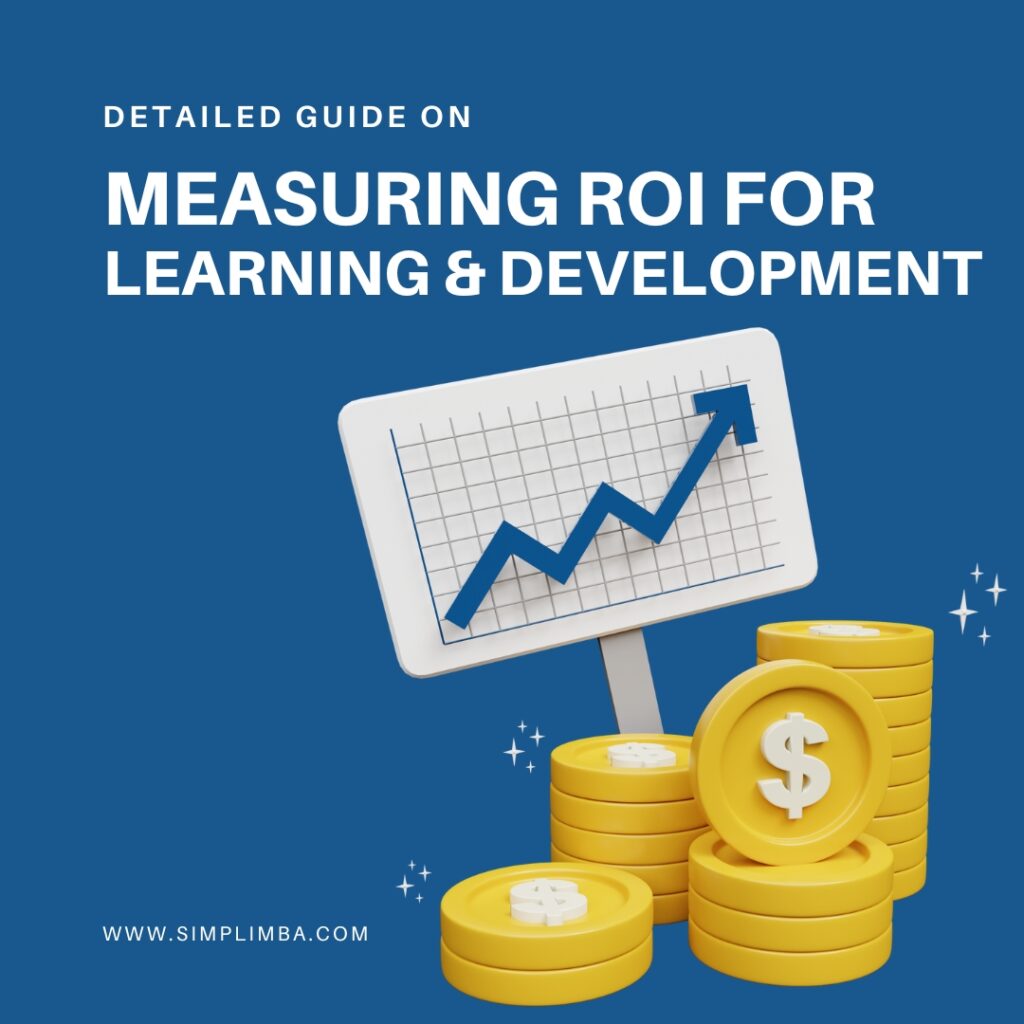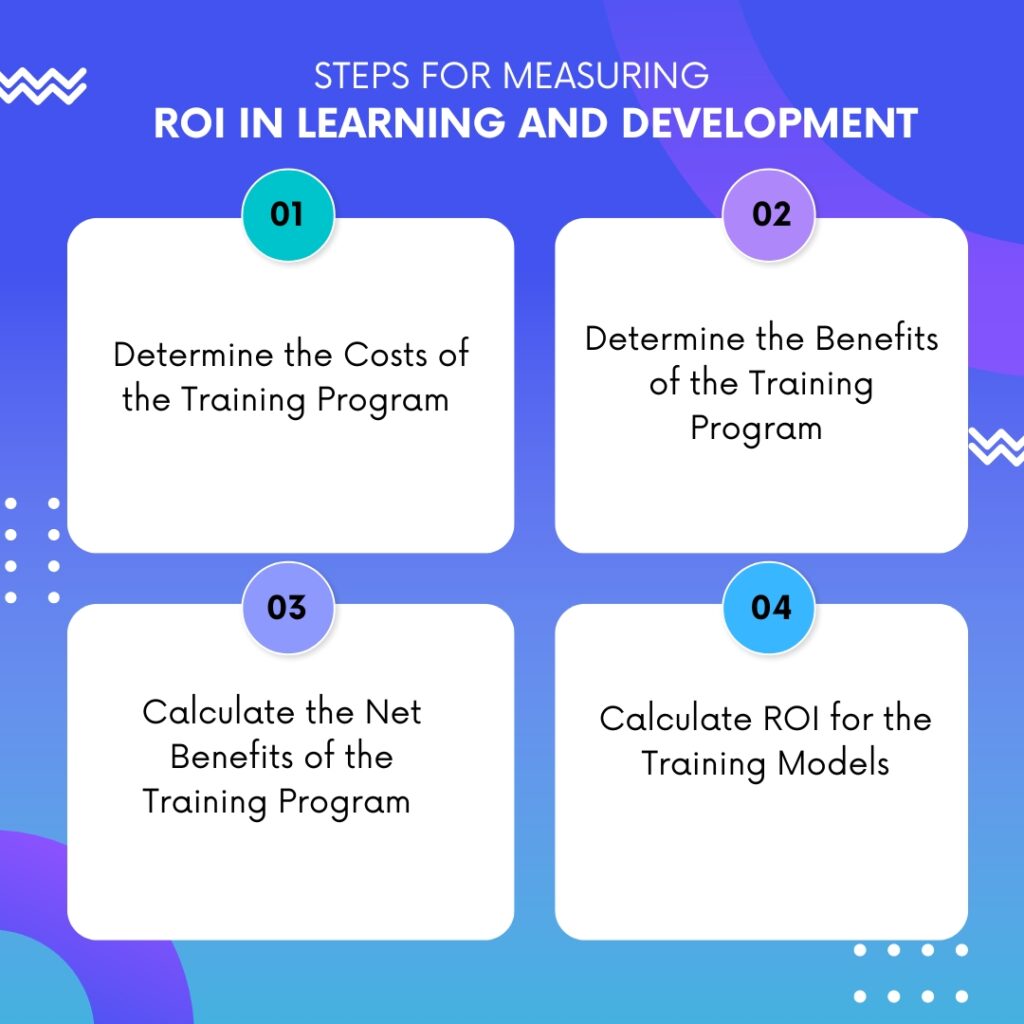We understand that measuring the Return on Investment (ROI) for learning and development programs is an essential aspect of evaluating the effectiveness of such programs. As businesses invest more in employee training, measuring the ROI of learning and development programs becomes increasingly important to ensure that training programs deliver value for money. In this article, we will provide a detailed guide on how to measure the ROI for training programs effectively.

Introduction
Employee learning and development is a critical component of any business strategy. Companies invest significant resources in employee training programs to enhance employee skills, increase productivity, and improve overall business performance.
According to the 2021 Workplace Learning Report by LinkedIn, 70% of professionals believe that training and development opportunities influence their decision to stay with a company. (Source: LinkedIn, Workplace Learning Report, 2021, https://learning.linkedin.com/resources/workplace-learning-report-2021)
However, without measuring the ROI of training programs, it is challenging to determine the effectiveness of these programs. Measuring ROI is crucial to ensure that the investment in training programs is justifiable.
Measuring ROI In Learning and Development
ROI for training programs is a metric that measures the value of training programs relative to their cost. It is an essential tool for evaluating the effectiveness of training programs and their impact on business outcomes. ROI for training programs is calculated by comparing the net benefits of training programs to the costs of the training program. It forms the base for measuring ROI in Learning and Development
ROI is then expressed as a percentage, as follows:
ROI = (Net Benefits of Training Program / Costs of Training Program) x 100
The higher the ROI, the more effective the training program is. However, calculating the ROI for training programs can be challenging. Let’s take a closer look at how to calculate the ROI for training programs.
Steps in measuring ROI in Learning and Development

Steps for Measuring ROI in Learning and Development
Step 1: Determine the Costs of the Training Program
The cost of the training program includes all direct and indirect expenses incurred to design, develop, deliver, and evaluate the training program. Direct costs may include salaries and wages of trainers, travel expenses, and material costs. Indirect costs may include overheads, such as rent, utilities, and administrative costs. The total cost of the training program should be recorded.
Step 2: Determine the Benefits of the Training Program
The benefits of the training program are the outcomes that result from the training program. These outcomes may include improved employee skills, increased productivity, and enhanced business performance. To determine the benefits of the training program, you may use various methods, such as surveys, interviews, and performance evaluations. The benefits of the training program should be recorded.
Step 3: Calculate the Net Benefits of the Training Program
To calculate the net benefits of the training program, you need to subtract the costs of the training program from the benefits of the training program. Net benefits represent the financial gain or loss resulting from the training program. If the net benefits are positive, the training program is considered to have generated a return on investment. If the net benefits are negative, the training program is considered to have incurred a loss.
Step 4: Calculate ROI for the Training Models
To calculate the ROI for the training program, you need to divide the net benefits of the training program by the costs of the training program and multiply by 100. The resulting percentage represents the ROI of the training program.
Why is measuring ROI in Learning and Development Important?
Measuring ROI in Learning and Development is critical for several reasons. Firstly, it helps to determine the effectiveness of training programs and whether they deliver value for money. Secondly, it enables businesses to make informed decisions about investing in future training programs. Thirdly, it helps businesses to allocate resources more effectively by identifying which training programs are the most effective.
In addition to measuring ROI, businesses should also focus on other metrics to evaluate the effectiveness of training programs. These metrics may include employee satisfaction, engagement, and retention rates. By using a combination of metrics, businesses can gain a comprehensive understanding of the impact of their training programs.
Furthermore, businesses should also consider the quality of their training programs. Quality training programs are essential for achieving high ROI. Quality training programs should be designed to meet the specific needs of employees and businesses, be delivered by qualified trainers, and incorporate interactive and engaging learning activities.
Finally, businesses should also ensure that their training programs align with their overall business strategy. By aligning training programs with business strategy, businesses can ensure that training programs are focused on achieving the desired outcomes and contribute to the overall success of the business.
To conclude, Measuring ROI in Learning and Development is an essential aspect of evaluating their effectiveness and impact on business outcomes. By following best practices for measuring ROI, focusing on quality training programs, and aligning training programs with business strategy, businesses can optimize their training programs and ensure that they deliver the desired outcomes.
How to isolate the effects of the training program into results?
Isolating the effects of training programs on business results can be a complex and challenging task. However, it is essential to isolate the effects of training programs to accurately measure their impact and determine their return on investment (ROI).
One of the most effective ways to isolate the effects of training programs is to use a control group. A control group is a group of employees who do not receive training but are otherwise similar to the group of employees who receive training. By comparing the performance of the trained group to the performance of the control group, businesses can determine the impact of training on business results.
Another effective method for isolating the effects of training programs is to use a pre-test and post-test design. In this design, employees are given a test before and after the training program to measure the impact of training on their knowledge and skills. By comparing the results of the pre-test and post-test, businesses can isolate the effects of training programs on employee performance.
In addition to using a control group or pre-test and post-test design, businesses can also use regression analysis to isolate the effects of training programs on business results. Regression analysis is a statistical technique that allows businesses to analyze the relationship between training and business results while controlling for other factors that may impact business outcomes.
Finally, businesses can also use qualitative data to isolate the effects of training programs. Qualitative data may include interviews, focus groups, or surveys with employees to gather their perceptions and experiences of the training program. By gathering qualitative data, businesses can gain a more comprehensive understanding of the impact of training programs on employee performance and business outcomes.
In conclusion, isolating the effects of training programs on business results is essential for accurately measuring their impact and determining their ROI. By using a control group, pre-test and post-test design, regression analysis, or qualitative data, businesses can isolate the effects of training programs and make data-driven decisions to optimize their training programs and achieve their desired outcomes.
Can Expert Opinion be used in measuring ROI in Learning and Development?

Yes, businesses can use trend analysis and expert opinion to evaluate the impact of their training programs.
Trend analysis involves analyzing historical data to identify patterns and trends. By analyzing trends in employee performance, businesses can determine the impact of training programs on business outcomes over time. Trend analysis can also help businesses identify areas for improvement and make data-driven decisions to optimize their training programs.
Expert opinion, on the other hand, involves gathering the opinions of subject matter experts to evaluate the impact of training programs. These experts may include trainers, instructional designers, or industry experts. By gathering expert opinions, businesses can gain valuable insights into the effectiveness of their training programs and identify areas for improvement.
Using both trend analysis and expert opinion can provide businesses with a comprehensive understanding of the impact of their training programs. Trend analysis can provide objective data on the effectiveness of training programs over time, while expert opinion can provide insights and recommendations for improving training programs based on industry expertise.
However, it is important to note that trend analysis and expert opinion should not be the sole basis for evaluating the impact of training programs. Businesses should also use quantitative metrics and rigorous evaluation methods, such as control groups and pre-test and post-test designs, to accurately measure the impact of training programs on business outcomes.
How intangible benefits be converted into monetary terms?
Converting training costs into monetary benefits for an organization can be a challenging task. However, there are several methods that businesses can use to correlate training costs to enhanced performances and calculate the monetary benefits of their training programs.
One method is to measure the return on investment (ROI) of training programs. ROI is a measure of the financial benefit of an investment relative to its cost. To calculate the ROI of a training program, businesses can use the following formula:
ROI = (Net Benefits of Training / Costs of Training) x 100
Net benefits of training refer to the financial gains achieved as a result of the training program, such as increased productivity, decreased turnover rates, and higher revenues. Costs of training include all the expenses associated with the training program, such as instructor fees, materials, and employee time.
By calculating the ROI of their training programs, businesses can determine whether the benefits of their training programs justify the costs. If the ROI is positive, it indicates that the financial benefits of the training program are greater than the costs, and the program is generating a positive return on investment for the organization.
Another method to correlate training costs to enhanced performance is to conduct a cost-benefit analysis. This analysis involves comparing the costs and benefits of a training program to determine whether the program is worth the investment. To conduct a cost-benefit analysis, businesses should identify all the costs and benefits associated with the training program and assign a monetary value to each.
Mathematical tools that can be used to analyze the data collected in the ROI and cost-benefit analyses include regression analysis, correlation analysis, and descriptive statistics. Regression analysis can be used to identify the relationships between training program costs and benefits, while correlation analysis can be used to determine the strength of these relationships. Descriptive statistics can be used to summarize and analyze the data collected in the analyses. This pursuit forms a basic premise of measuring ROI in Learning and Development and helps drive data-driven decision-making in organizations
Measuring ROI in Learning and Development: Various Models
Models for Measuring ROI of Learning and Development
Training and development are essential parts of any business strategy. However, it can be challenging to measure the Return on Investment (ROI) of such programs accurately. This is why several models have been developed to help organizations assess the effectiveness of their training and development initiatives and help in Measuring ROI in Learning and Development. In this article, we will discuss some of the most popular models for measuring ROI in Learning and Development, including the Philips ROI Model, Supervisor Assessment, Brinkerhoff model, and Kodo Survey.
Philips ROI Model
The Philips ROI Model is a five-level approach to measuring ROI in Learning and Development. This model is based on the premise that an organization’s investment in training and development should result in a positive impact on business results. The five levels of the Philips ROI Model are:
Reaction and Satisfaction: This level measures participants’ satisfaction with the training program.
Learning: This level assesses the knowledge and skills gained from the training program.
Application: This level measures the extent to which participants apply what they learned in the workplace.
Business Impact: This level evaluates the impact of the training program on the business, such as increased productivity or reduced costs.
ROI: This level measures the financial return on investment of the training program.
Supervisor Assessment
Supervisor assessment is a simple and effective model for measuring ROI in Learning and Development. This model involves asking supervisors to evaluate the performance of employees who have completed a training program. By comparing the performance of trained and untrained employees, organizations can determine the impact of training on business results.
Brinkerhoff Model
The Brinkerhoff model is a six-level approach to measuring ROI in Learning and Development. This model focuses on the impact of training on individual employees and their ability to perform their job duties. The six levels of the Brinkerhoff model are:
Reaction: This level measures participants’ satisfaction with the training program.
Learning: This level assesses the knowledge and skills gained from the training program.
Application: This level measures the extent to which participants apply what they learned in the workplace.
Business Impact: This level evaluates the impact of the training program on the individual’s job performance.
Organizational Impact: This level assesses the impact of the training program on the organization, such as increased productivity or reduced costs.
ROI: This level measures the financial return on investment of the training program.
Difference between various models of measuring ROI in Learning and Development
Here is a tabulated difference between the four models for measuring the ROI of training and development:
| Model | Number of Levels | Key Features |
| Philips ROI Model | 5 | * Emphasizes that training should result in a positive impact on business results * Measures participants’ satisfaction with the training program * Assesses the knowledge and skills gained from the training program * Measures the extent to which participants apply what they learned in the workplace * Evaluates the impact of the training program on the business * Measures the financial return on investment of the training program |
| Supervisor Assessment | 1 | * Simple and effective model for measuring ROI in Learning and Development * Involves asking supervisors to evaluate the performance of employees who have completed a training program * Compares the performance of trained and untrained employees |
| Brinkerhoff Model | 6 | * Focuses on the impact of training on individual employees and their ability to perform their job duties * Measures participants’ satisfaction with the training program * Assesses the knowledge and skills gained from the training program * Measures the extent to which participants apply what they learned in the workplace * Evaluates the impact of the training program on the individual’s job performance * Assesses the impact of the training program on the organization * Measures the financial return on investment of the training program |
Conclusion
In conclusion, businesses can convert their training costs into monetary benefits by Measuring ROI in Learning and Development and conducting cost-benefit analyses. These methods can help businesses determine the financial benefits of their training programs and make data-driven decisions to optimize their training programs and achieve their desired outcomes. Mathematical tools such as regression analysis, correlation analysis, and descriptive statistics can be used to analyze the data collected in these analyses and gain valuable insights into the effectiveness of training programs.
Samrat is a Delhi-based MBA from the Indian Institute of Management. He is a Strategy, AI, and Marketing Enthusiast and passionately writes about core and emerging topics in Management studies. Reach out to his LinkedIn for a discussion or follow his Quora Page
